A Comparative Analysis of HIV/AIDS and Social Determinants of Health
VerifiedAdded on 2021/11/01
|8
|2214
|55
Report
AI Summary
This report provides a comparative analysis of HIV/AIDS among sex workers in Australia and Thailand, focusing on the social determinants of health. It examines the impact of living environments, healthcare systems, and economic conditions on the prevalence and management of HIV/AIDS within this vulnerable population. The report highlights the differences in living standards, access to healthcare, and educational infrastructure between the two countries, illustrating how these factors influence the risk and outcomes of HIV/AIDS. In Australia, better living conditions, stricter brothel regulations, and a robust healthcare system contribute to lower HIV rates among sex workers. Conversely, Thailand faces challenges due to poverty, sex tourism, and inadequate healthcare, leading to higher HIV prevalence. The report underscores the importance of safe sex practices, education, and accessible healthcare in mitigating the spread of HIV/AIDS within the sex worker community and the broader population. It concludes by emphasizing the need for improved policies and interventions to support sex workers' health and well-being.
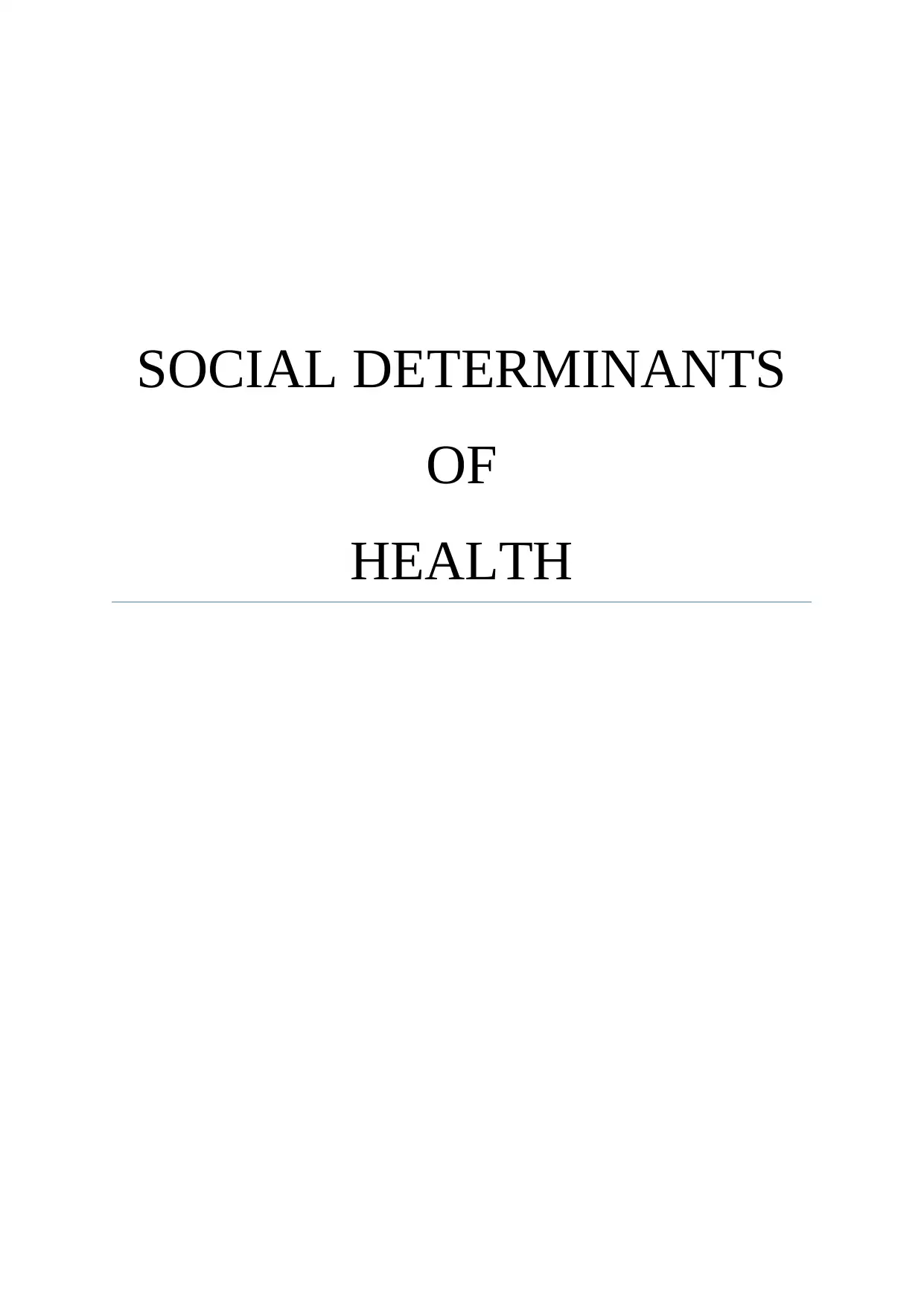
SOCIAL DETERMINANTS
OF
HEALTH
OF
HEALTH
Paraphrase This Document
Need a fresh take? Get an instant paraphrase of this document with our AI Paraphraser
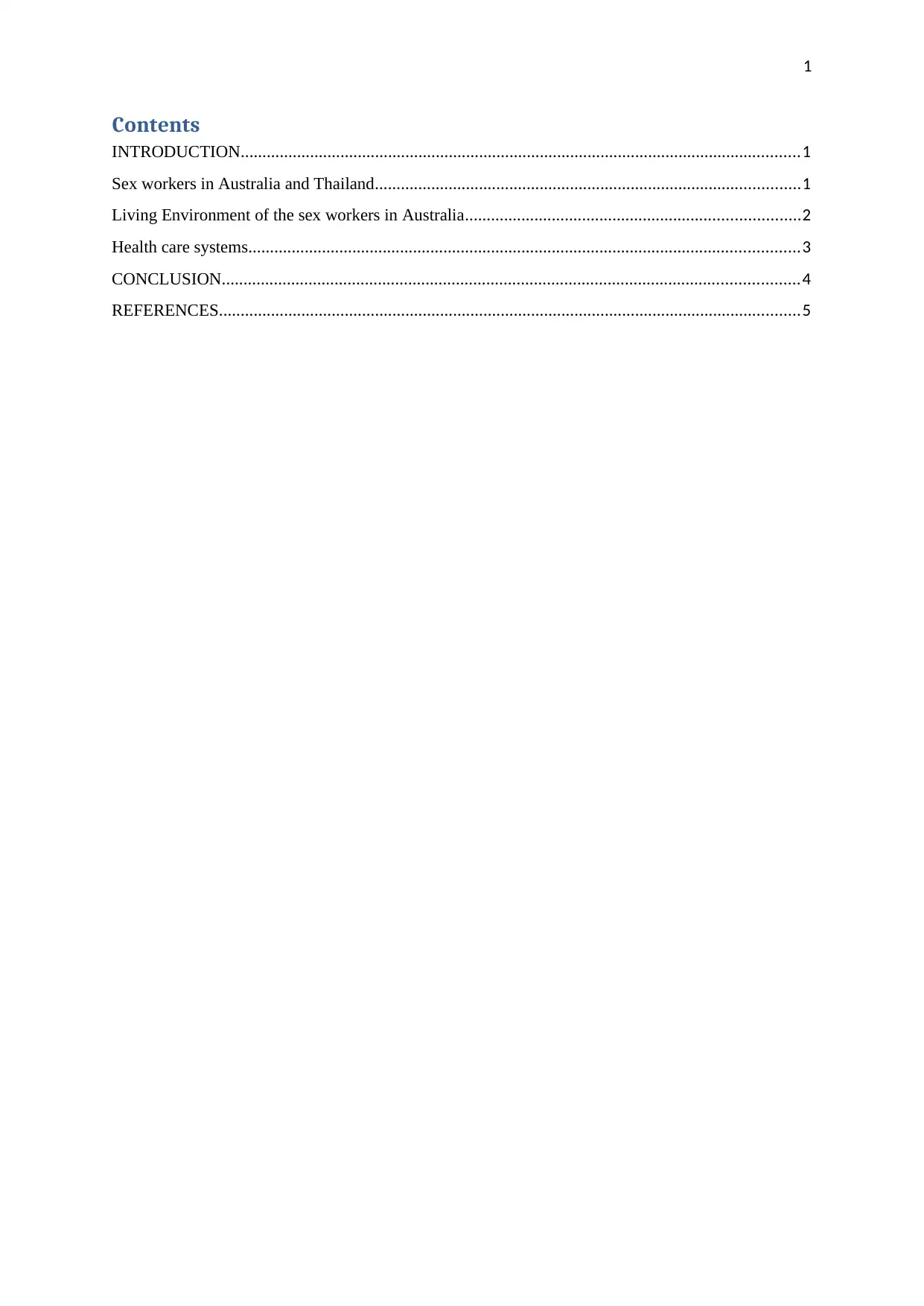
1
Contents
INTRODUCTION.................................................................................................................................1
Sex workers in Australia and Thailand..................................................................................................1
Living Environment of the sex workers in Australia.............................................................................2
Health care systems...............................................................................................................................3
CONCLUSION.....................................................................................................................................4
REFERENCES......................................................................................................................................5
Contents
INTRODUCTION.................................................................................................................................1
Sex workers in Australia and Thailand..................................................................................................1
Living Environment of the sex workers in Australia.............................................................................2
Health care systems...............................................................................................................................3
CONCLUSION.....................................................................................................................................4
REFERENCES......................................................................................................................................5
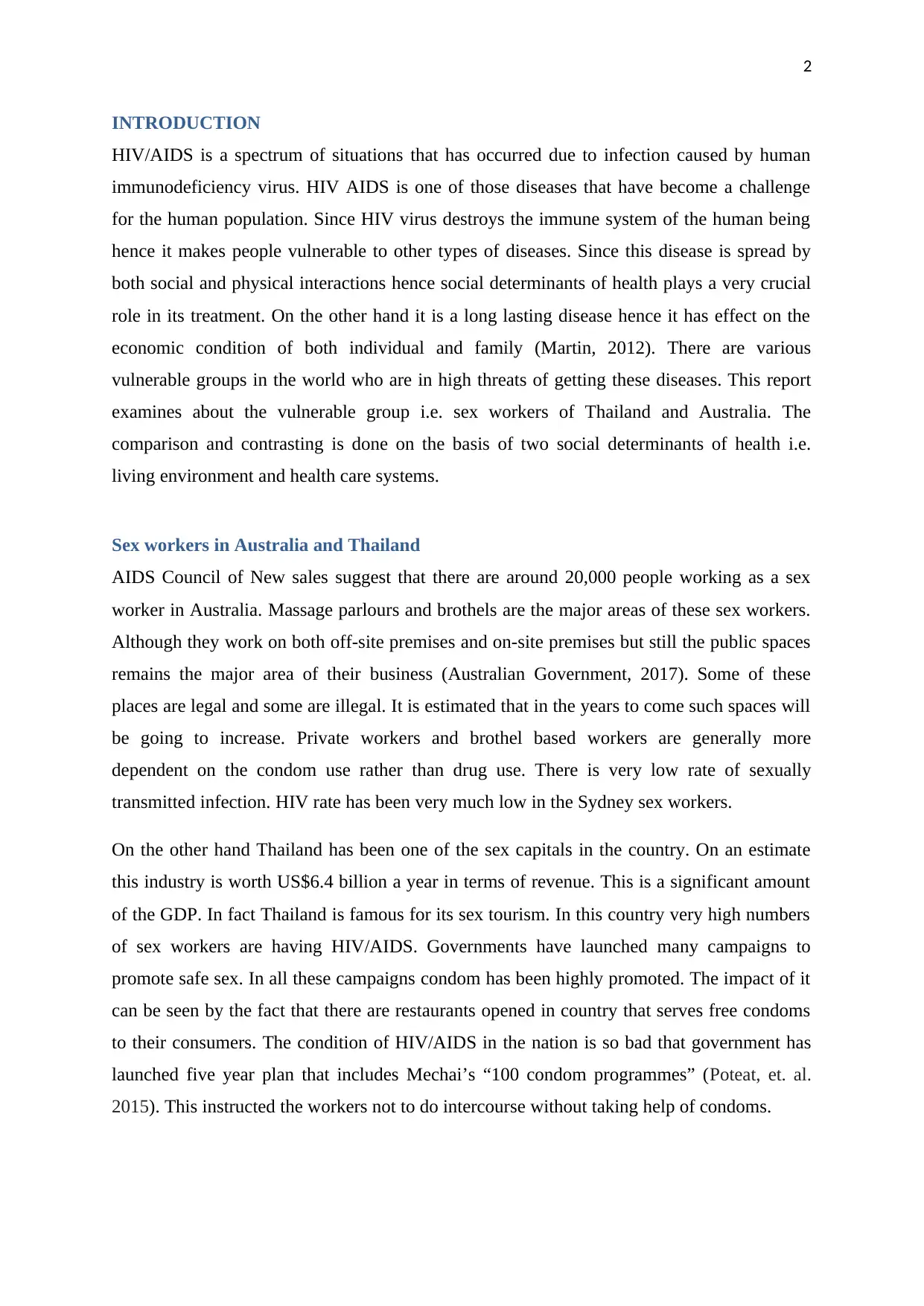
2
INTRODUCTION
HIV/AIDS is a spectrum of situations that has occurred due to infection caused by human
immunodeficiency virus. HIV AIDS is one of those diseases that have become a challenge
for the human population. Since HIV virus destroys the immune system of the human being
hence it makes people vulnerable to other types of diseases. Since this disease is spread by
both social and physical interactions hence social determinants of health plays a very crucial
role in its treatment. On the other hand it is a long lasting disease hence it has effect on the
economic condition of both individual and family (Martin, 2012). There are various
vulnerable groups in the world who are in high threats of getting these diseases. This report
examines about the vulnerable group i.e. sex workers of Thailand and Australia. The
comparison and contrasting is done on the basis of two social determinants of health i.e.
living environment and health care systems.
Sex workers in Australia and Thailand
AIDS Council of New sales suggest that there are around 20,000 people working as a sex
worker in Australia. Massage parlours and brothels are the major areas of these sex workers.
Although they work on both off-site premises and on-site premises but still the public spaces
remains the major area of their business (Australian Government, 2017). Some of these
places are legal and some are illegal. It is estimated that in the years to come such spaces will
be going to increase. Private workers and brothel based workers are generally more
dependent on the condom use rather than drug use. There is very low rate of sexually
transmitted infection. HIV rate has been very much low in the Sydney sex workers.
On the other hand Thailand has been one of the sex capitals in the country. On an estimate
this industry is worth US$6.4 billion a year in terms of revenue. This is a significant amount
of the GDP. In fact Thailand is famous for its sex tourism. In this country very high numbers
of sex workers are having HIV/AIDS. Governments have launched many campaigns to
promote safe sex. In all these campaigns condom has been highly promoted. The impact of it
can be seen by the fact that there are restaurants opened in country that serves free condoms
to their consumers. The condition of HIV/AIDS in the nation is so bad that government has
launched five year plan that includes Mechai’s “100 condom programmes” (Poteat, et. al.
2015). This instructed the workers not to do intercourse without taking help of condoms.
INTRODUCTION
HIV/AIDS is a spectrum of situations that has occurred due to infection caused by human
immunodeficiency virus. HIV AIDS is one of those diseases that have become a challenge
for the human population. Since HIV virus destroys the immune system of the human being
hence it makes people vulnerable to other types of diseases. Since this disease is spread by
both social and physical interactions hence social determinants of health plays a very crucial
role in its treatment. On the other hand it is a long lasting disease hence it has effect on the
economic condition of both individual and family (Martin, 2012). There are various
vulnerable groups in the world who are in high threats of getting these diseases. This report
examines about the vulnerable group i.e. sex workers of Thailand and Australia. The
comparison and contrasting is done on the basis of two social determinants of health i.e.
living environment and health care systems.
Sex workers in Australia and Thailand
AIDS Council of New sales suggest that there are around 20,000 people working as a sex
worker in Australia. Massage parlours and brothels are the major areas of these sex workers.
Although they work on both off-site premises and on-site premises but still the public spaces
remains the major area of their business (Australian Government, 2017). Some of these
places are legal and some are illegal. It is estimated that in the years to come such spaces will
be going to increase. Private workers and brothel based workers are generally more
dependent on the condom use rather than drug use. There is very low rate of sexually
transmitted infection. HIV rate has been very much low in the Sydney sex workers.
On the other hand Thailand has been one of the sex capitals in the country. On an estimate
this industry is worth US$6.4 billion a year in terms of revenue. This is a significant amount
of the GDP. In fact Thailand is famous for its sex tourism. In this country very high numbers
of sex workers are having HIV/AIDS. Governments have launched many campaigns to
promote safe sex. In all these campaigns condom has been highly promoted. The impact of it
can be seen by the fact that there are restaurants opened in country that serves free condoms
to their consumers. The condition of HIV/AIDS in the nation is so bad that government has
launched five year plan that includes Mechai’s “100 condom programmes” (Poteat, et. al.
2015). This instructed the workers not to do intercourse without taking help of condoms.
⊘ This is a preview!⊘
Do you want full access?
Subscribe today to unlock all pages.

Trusted by 1+ million students worldwide
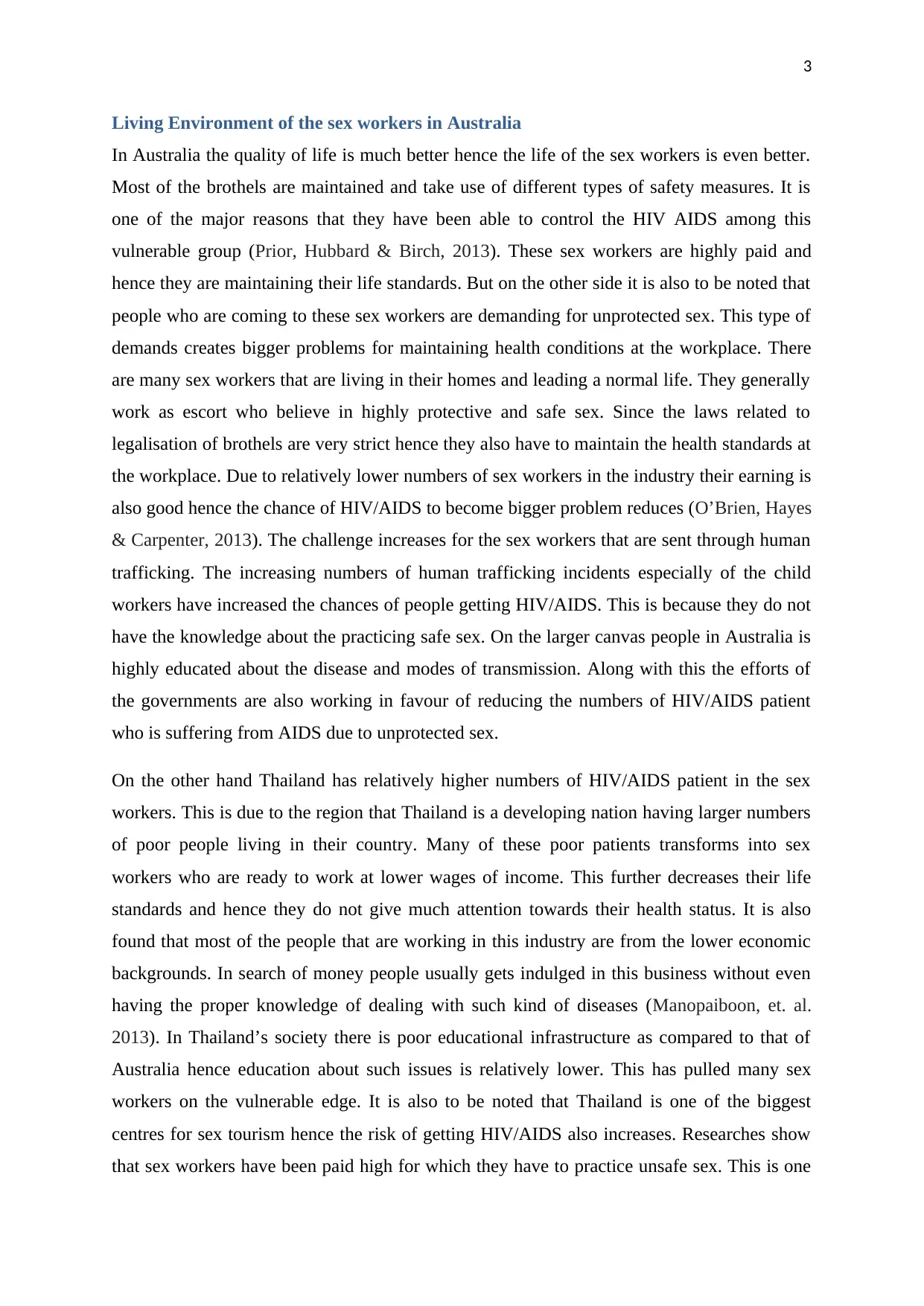
3
Living Environment of the sex workers in Australia
In Australia the quality of life is much better hence the life of the sex workers is even better.
Most of the brothels are maintained and take use of different types of safety measures. It is
one of the major reasons that they have been able to control the HIV AIDS among this
vulnerable group (Prior, Hubbard & Birch, 2013). These sex workers are highly paid and
hence they are maintaining their life standards. But on the other side it is also to be noted that
people who are coming to these sex workers are demanding for unprotected sex. This type of
demands creates bigger problems for maintaining health conditions at the workplace. There
are many sex workers that are living in their homes and leading a normal life. They generally
work as escort who believe in highly protective and safe sex. Since the laws related to
legalisation of brothels are very strict hence they also have to maintain the health standards at
the workplace. Due to relatively lower numbers of sex workers in the industry their earning is
also good hence the chance of HIV/AIDS to become bigger problem reduces (O’Brien, Hayes
& Carpenter, 2013). The challenge increases for the sex workers that are sent through human
trafficking. The increasing numbers of human trafficking incidents especially of the child
workers have increased the chances of people getting HIV/AIDS. This is because they do not
have the knowledge about the practicing safe sex. On the larger canvas people in Australia is
highly educated about the disease and modes of transmission. Along with this the efforts of
the governments are also working in favour of reducing the numbers of HIV/AIDS patient
who is suffering from AIDS due to unprotected sex.
On the other hand Thailand has relatively higher numbers of HIV/AIDS patient in the sex
workers. This is due to the region that Thailand is a developing nation having larger numbers
of poor people living in their country. Many of these poor patients transforms into sex
workers who are ready to work at lower wages of income. This further decreases their life
standards and hence they do not give much attention towards their health status. It is also
found that most of the people that are working in this industry are from the lower economic
backgrounds. In search of money people usually gets indulged in this business without even
having the proper knowledge of dealing with such kind of diseases (Manopaiboon, et. al.
2013). In Thailand’s society there is poor educational infrastructure as compared to that of
Australia hence education about such issues is relatively lower. This has pulled many sex
workers on the vulnerable edge. It is also to be noted that Thailand is one of the biggest
centres for sex tourism hence the risk of getting HIV/AIDS also increases. Researches show
that sex workers have been paid high for which they have to practice unsafe sex. This is one
Living Environment of the sex workers in Australia
In Australia the quality of life is much better hence the life of the sex workers is even better.
Most of the brothels are maintained and take use of different types of safety measures. It is
one of the major reasons that they have been able to control the HIV AIDS among this
vulnerable group (Prior, Hubbard & Birch, 2013). These sex workers are highly paid and
hence they are maintaining their life standards. But on the other side it is also to be noted that
people who are coming to these sex workers are demanding for unprotected sex. This type of
demands creates bigger problems for maintaining health conditions at the workplace. There
are many sex workers that are living in their homes and leading a normal life. They generally
work as escort who believe in highly protective and safe sex. Since the laws related to
legalisation of brothels are very strict hence they also have to maintain the health standards at
the workplace. Due to relatively lower numbers of sex workers in the industry their earning is
also good hence the chance of HIV/AIDS to become bigger problem reduces (O’Brien, Hayes
& Carpenter, 2013). The challenge increases for the sex workers that are sent through human
trafficking. The increasing numbers of human trafficking incidents especially of the child
workers have increased the chances of people getting HIV/AIDS. This is because they do not
have the knowledge about the practicing safe sex. On the larger canvas people in Australia is
highly educated about the disease and modes of transmission. Along with this the efforts of
the governments are also working in favour of reducing the numbers of HIV/AIDS patient
who is suffering from AIDS due to unprotected sex.
On the other hand Thailand has relatively higher numbers of HIV/AIDS patient in the sex
workers. This is due to the region that Thailand is a developing nation having larger numbers
of poor people living in their country. Many of these poor patients transforms into sex
workers who are ready to work at lower wages of income. This further decreases their life
standards and hence they do not give much attention towards their health status. It is also
found that most of the people that are working in this industry are from the lower economic
backgrounds. In search of money people usually gets indulged in this business without even
having the proper knowledge of dealing with such kind of diseases (Manopaiboon, et. al.
2013). In Thailand’s society there is poor educational infrastructure as compared to that of
Australia hence education about such issues is relatively lower. This has pulled many sex
workers on the vulnerable edge. It is also to be noted that Thailand is one of the biggest
centres for sex tourism hence the risk of getting HIV/AIDS also increases. Researches show
that sex workers have been paid high for which they have to practice unsafe sex. This is one
Paraphrase This Document
Need a fresh take? Get an instant paraphrase of this document with our AI Paraphraser
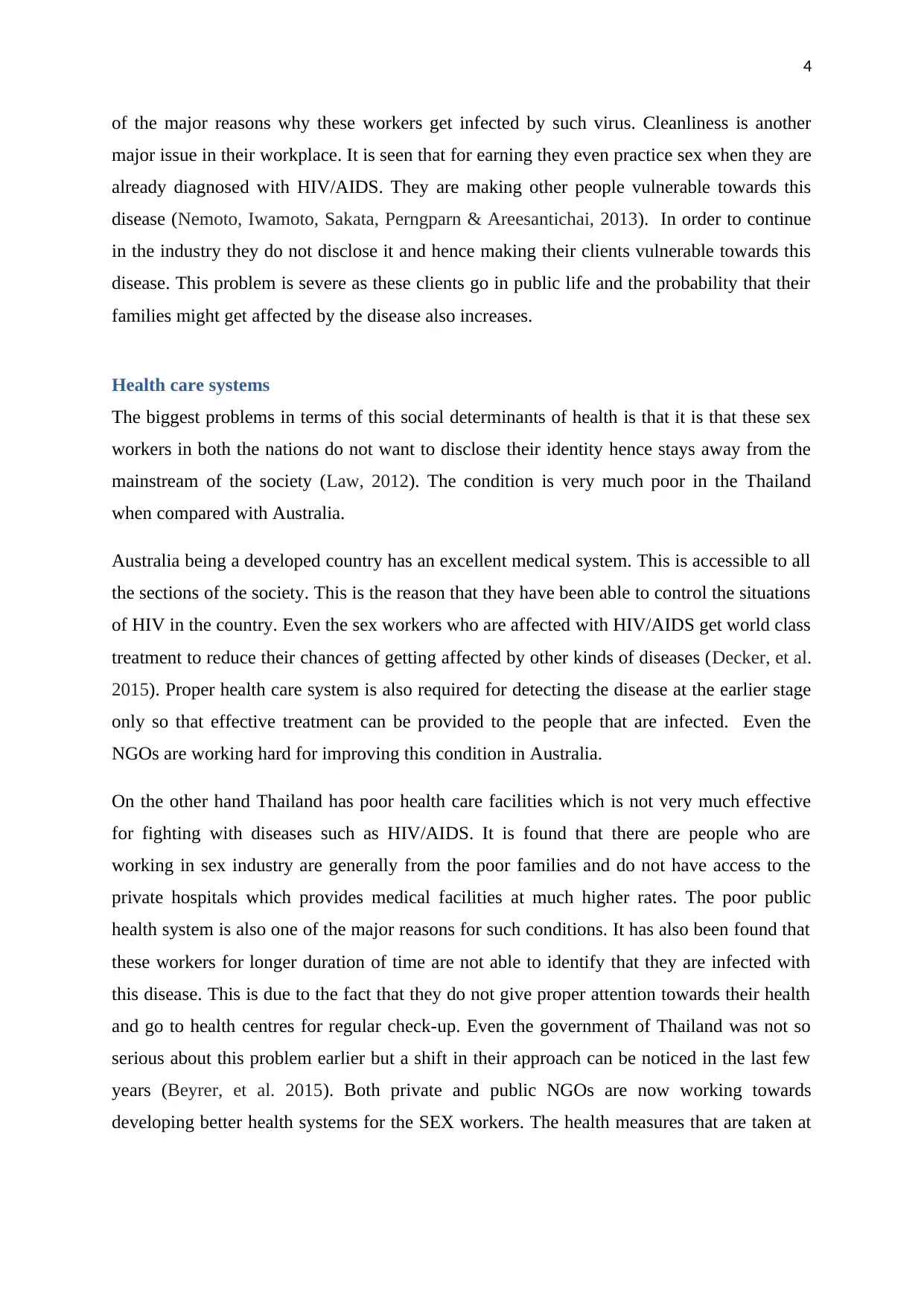
4
of the major reasons why these workers get infected by such virus. Cleanliness is another
major issue in their workplace. It is seen that for earning they even practice sex when they are
already diagnosed with HIV/AIDS. They are making other people vulnerable towards this
disease (Nemoto, Iwamoto, Sakata, Perngparn & Areesantichai, 2013). In order to continue
in the industry they do not disclose it and hence making their clients vulnerable towards this
disease. This problem is severe as these clients go in public life and the probability that their
families might get affected by the disease also increases.
Health care systems
The biggest problems in terms of this social determinants of health is that it is that these sex
workers in both the nations do not want to disclose their identity hence stays away from the
mainstream of the society (Law, 2012). The condition is very much poor in the Thailand
when compared with Australia.
Australia being a developed country has an excellent medical system. This is accessible to all
the sections of the society. This is the reason that they have been able to control the situations
of HIV in the country. Even the sex workers who are affected with HIV/AIDS get world class
treatment to reduce their chances of getting affected by other kinds of diseases (Decker, et al.
2015). Proper health care system is also required for detecting the disease at the earlier stage
only so that effective treatment can be provided to the people that are infected. Even the
NGOs are working hard for improving this condition in Australia.
On the other hand Thailand has poor health care facilities which is not very much effective
for fighting with diseases such as HIV/AIDS. It is found that there are people who are
working in sex industry are generally from the poor families and do not have access to the
private hospitals which provides medical facilities at much higher rates. The poor public
health system is also one of the major reasons for such conditions. It has also been found that
these workers for longer duration of time are not able to identify that they are infected with
this disease. This is due to the fact that they do not give proper attention towards their health
and go to health centres for regular check-up. Even the government of Thailand was not so
serious about this problem earlier but a shift in their approach can be noticed in the last few
years (Beyrer, et al. 2015). Both private and public NGOs are now working towards
developing better health systems for the SEX workers. The health measures that are taken at
of the major reasons why these workers get infected by such virus. Cleanliness is another
major issue in their workplace. It is seen that for earning they even practice sex when they are
already diagnosed with HIV/AIDS. They are making other people vulnerable towards this
disease (Nemoto, Iwamoto, Sakata, Perngparn & Areesantichai, 2013). In order to continue
in the industry they do not disclose it and hence making their clients vulnerable towards this
disease. This problem is severe as these clients go in public life and the probability that their
families might get affected by the disease also increases.
Health care systems
The biggest problems in terms of this social determinants of health is that it is that these sex
workers in both the nations do not want to disclose their identity hence stays away from the
mainstream of the society (Law, 2012). The condition is very much poor in the Thailand
when compared with Australia.
Australia being a developed country has an excellent medical system. This is accessible to all
the sections of the society. This is the reason that they have been able to control the situations
of HIV in the country. Even the sex workers who are affected with HIV/AIDS get world class
treatment to reduce their chances of getting affected by other kinds of diseases (Decker, et al.
2015). Proper health care system is also required for detecting the disease at the earlier stage
only so that effective treatment can be provided to the people that are infected. Even the
NGOs are working hard for improving this condition in Australia.
On the other hand Thailand has poor health care facilities which is not very much effective
for fighting with diseases such as HIV/AIDS. It is found that there are people who are
working in sex industry are generally from the poor families and do not have access to the
private hospitals which provides medical facilities at much higher rates. The poor public
health system is also one of the major reasons for such conditions. It has also been found that
these workers for longer duration of time are not able to identify that they are infected with
this disease. This is due to the fact that they do not give proper attention towards their health
and go to health centres for regular check-up. Even the government of Thailand was not so
serious about this problem earlier but a shift in their approach can be noticed in the last few
years (Beyrer, et al. 2015). Both private and public NGOs are now working towards
developing better health systems for the SEX workers. The health measures that are taken at
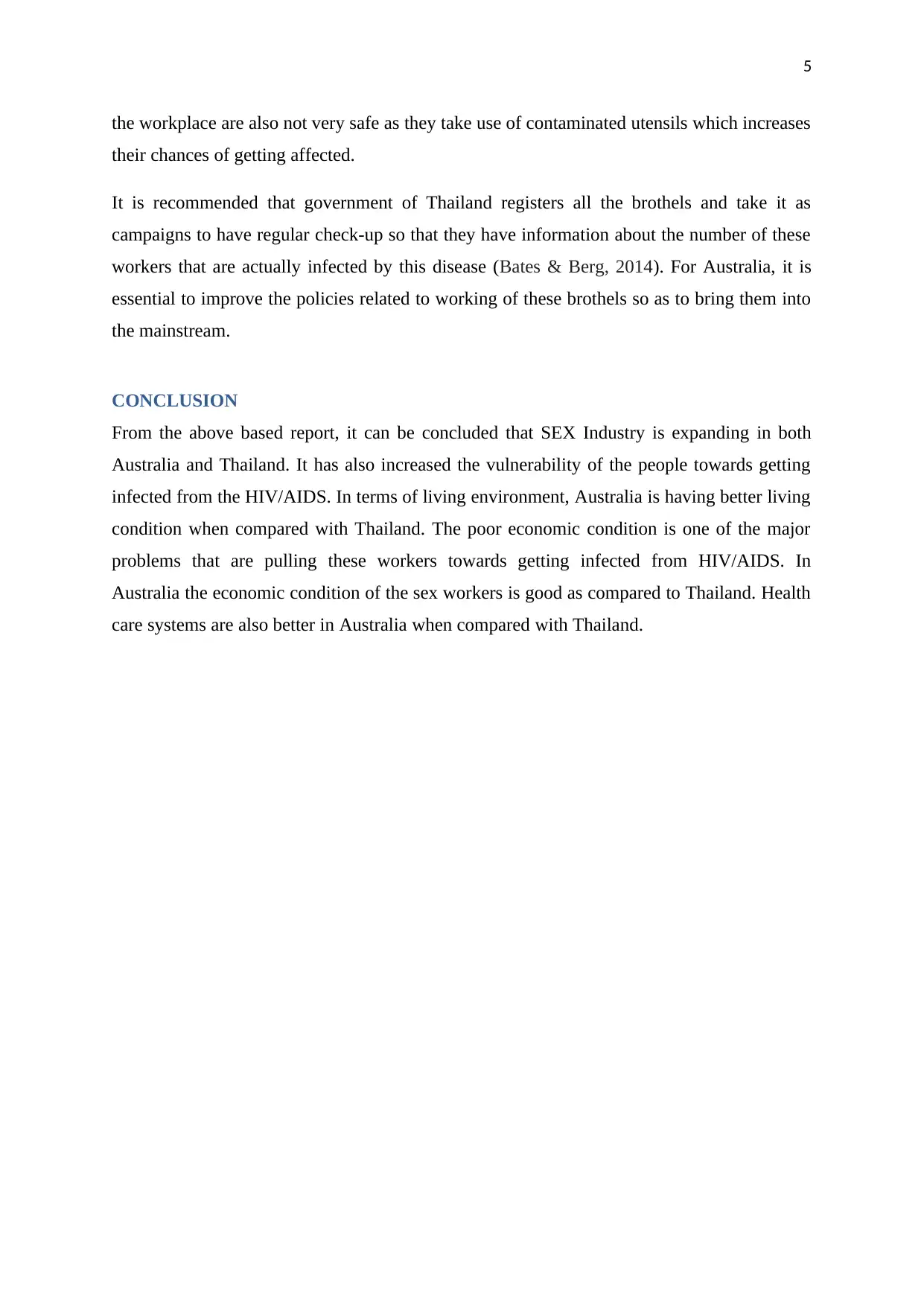
5
the workplace are also not very safe as they take use of contaminated utensils which increases
their chances of getting affected.
It is recommended that government of Thailand registers all the brothels and take it as
campaigns to have regular check-up so that they have information about the number of these
workers that are actually infected by this disease (Bates & Berg, 2014). For Australia, it is
essential to improve the policies related to working of these brothels so as to bring them into
the mainstream.
CONCLUSION
From the above based report, it can be concluded that SEX Industry is expanding in both
Australia and Thailand. It has also increased the vulnerability of the people towards getting
infected from the HIV/AIDS. In terms of living environment, Australia is having better living
condition when compared with Thailand. The poor economic condition is one of the major
problems that are pulling these workers towards getting infected from HIV/AIDS. In
Australia the economic condition of the sex workers is good as compared to Thailand. Health
care systems are also better in Australia when compared with Thailand.
the workplace are also not very safe as they take use of contaminated utensils which increases
their chances of getting affected.
It is recommended that government of Thailand registers all the brothels and take it as
campaigns to have regular check-up so that they have information about the number of these
workers that are actually infected by this disease (Bates & Berg, 2014). For Australia, it is
essential to improve the policies related to working of these brothels so as to bring them into
the mainstream.
CONCLUSION
From the above based report, it can be concluded that SEX Industry is expanding in both
Australia and Thailand. It has also increased the vulnerability of the people towards getting
infected from the HIV/AIDS. In terms of living environment, Australia is having better living
condition when compared with Thailand. The poor economic condition is one of the major
problems that are pulling these workers towards getting infected from HIV/AIDS. In
Australia the economic condition of the sex workers is good as compared to Thailand. Health
care systems are also better in Australia when compared with Thailand.
⊘ This is a preview!⊘
Do you want full access?
Subscribe today to unlock all pages.

Trusted by 1+ million students worldwide

6
REFERENCES
Australian Government, (2017) The Australian sex industry. Retrieved from:
https://aic.gov.au/publications/rpp/rpp131/australian-sex-industry
Bates, J., & Berg, R. (2014). Sex workers as safe sex advocates: sex workers protect both
themselves and the wider community from HIV. AIDS Education and
Prevention, 26(3), 191-201.
Beyrer, C., Crago, A. L., Bekker, L. G., Butler, J., Shannon, K., Kerrigan, D., ... & Weir, B.
W. (2015). An action agenda for HIV and sex workers. The Lancet, 385(9964), 287-
301.
Decker, M. R., Crago, A. L., Chu, S. K., Sherman, S. G., Seshu, M. S., Buthelezi, K., ... &
Beyrer, C. (2015). Human rights violations against sex workers: burden and effect on
HIV. The Lancet, 385(9963), 186-199.
Law, L. (2012). Sex work in Southeast Asia: The place of desire in a time of AIDS.
Routledge.
Manopaiboon, C., Prybylski, D., Subhachaturas, W., Tanpradech, S., Suksripanich, O.,
Siangphoe, U., ... & Whitehead, S. J. (2013). Unexpectedly high HIV prevalence
among female sex workers in Bangkok, Thailand in a respondent-driven sampling
survey. International journal of STD & AIDS, 24(1), 34-38.
Martin, A. (2012) The Social and Economic Determinants of HIV/AIDS: Time for Action.
Retrieved from: http://www.thebodypro.com/content/69725/the-social-and-economic-
determinants-of-hivaids-ti.html
Nemoto, T., Iwamoto, M., Sakata, M., Perngparn, U., & Areesantichai, C. (2013). Social and
cultural contexts of HIV risk behaviors among Thai female sex workers in Bangkok,
Thailand. AIDS care, 25(5), 613-618.
O’Brien, E., Hayes, S., & Carpenter, B. (2013). The politics of sex trafficking. In The Politics
of Sex Trafficking (pp. 1-20). Palgrave Macmillan, London.
REFERENCES
Australian Government, (2017) The Australian sex industry. Retrieved from:
https://aic.gov.au/publications/rpp/rpp131/australian-sex-industry
Bates, J., & Berg, R. (2014). Sex workers as safe sex advocates: sex workers protect both
themselves and the wider community from HIV. AIDS Education and
Prevention, 26(3), 191-201.
Beyrer, C., Crago, A. L., Bekker, L. G., Butler, J., Shannon, K., Kerrigan, D., ... & Weir, B.
W. (2015). An action agenda for HIV and sex workers. The Lancet, 385(9964), 287-
301.
Decker, M. R., Crago, A. L., Chu, S. K., Sherman, S. G., Seshu, M. S., Buthelezi, K., ... &
Beyrer, C. (2015). Human rights violations against sex workers: burden and effect on
HIV. The Lancet, 385(9963), 186-199.
Law, L. (2012). Sex work in Southeast Asia: The place of desire in a time of AIDS.
Routledge.
Manopaiboon, C., Prybylski, D., Subhachaturas, W., Tanpradech, S., Suksripanich, O.,
Siangphoe, U., ... & Whitehead, S. J. (2013). Unexpectedly high HIV prevalence
among female sex workers in Bangkok, Thailand in a respondent-driven sampling
survey. International journal of STD & AIDS, 24(1), 34-38.
Martin, A. (2012) The Social and Economic Determinants of HIV/AIDS: Time for Action.
Retrieved from: http://www.thebodypro.com/content/69725/the-social-and-economic-
determinants-of-hivaids-ti.html
Nemoto, T., Iwamoto, M., Sakata, M., Perngparn, U., & Areesantichai, C. (2013). Social and
cultural contexts of HIV risk behaviors among Thai female sex workers in Bangkok,
Thailand. AIDS care, 25(5), 613-618.
O’Brien, E., Hayes, S., & Carpenter, B. (2013). The politics of sex trafficking. In The Politics
of Sex Trafficking (pp. 1-20). Palgrave Macmillan, London.
Paraphrase This Document
Need a fresh take? Get an instant paraphrase of this document with our AI Paraphraser

7
Poteat, T., Wirtz, A. L., Radix, A., Borquez, A., Silva-Santisteban, A., Deutsch, M. B., ... &
Operario, D. (2015). HIV risk and preventive interventions in transgender women sex
workers. The Lancet, 385(9964), 274-286.
Prior, J., Hubbard, P., & Birch, P. (2013). Sex worker victimization, modes of working, and
location in New South Wales, Australia: a geography of victimization. Journal of Sex
Research, 50(6), 574-586.
Poteat, T., Wirtz, A. L., Radix, A., Borquez, A., Silva-Santisteban, A., Deutsch, M. B., ... &
Operario, D. (2015). HIV risk and preventive interventions in transgender women sex
workers. The Lancet, 385(9964), 274-286.
Prior, J., Hubbard, P., & Birch, P. (2013). Sex worker victimization, modes of working, and
location in New South Wales, Australia: a geography of victimization. Journal of Sex
Research, 50(6), 574-586.
1 out of 8
Related Documents
Your All-in-One AI-Powered Toolkit for Academic Success.
+13062052269
info@desklib.com
Available 24*7 on WhatsApp / Email
![[object Object]](/_next/static/media/star-bottom.7253800d.svg)
Unlock your academic potential
Copyright © 2020–2025 A2Z Services. All Rights Reserved. Developed and managed by ZUCOL.





